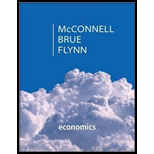
The four-firm concentration ratio and Herfindahl index.
Explanation of Solution
The four-firm concentration ratio helps to identify the extent of the market share handled by the four largest firms in the industry. The four largest firms’ market shares are 23%, 22%, 18% and 12% respectively. The four-firm concentration ratio can be calculated by adding the market shares of the four largest firms in the industry as follows:
Thus, the four-firm concentration ratio is 75%.
The Herfindahl index can be calculated by squaring the market share of each firm and summing them together. We have the market shares of the industry as follows: 23, 22, 18, 12, 11, 8 and 6. The Herfindahl index can be calculated as follows:
The HHI index of the industry is 1072.
When the top three firms are combined to form a single firm, the four-firm concentration ratio as well as the Herfindahl index will change as follows:
The four-firm concentration ratio helps to identify the extent of the market share handled by the four largest firms in the industry. The four largest firms’ market shares are 63%, 12%, 11% and 8%, respectively. The four-firm concentration ratio can be calculated by adding the market shares of four largest firms in the industry as follows:
Thus, the new four-firm concentration ratio is 94%.
The Herfindahl index can be calculated by squaring the market share of each firm and summing them together. We have the market shares of the industry as follows: 63, 12, 11, 8 and 6. The Herfindahl index can be calculated as follows:
The new HHI index of the industry is 4334.
Concept introduction:
Four-firm concentration ratio: The four-firm concentration ratio is the total market share handled by the four largest firms in the industry. It helps to identify the extent of the market controls of the four largest firms in the industry.
Herfindahl index: The Herfindahl index is the measure of the concentration of the market. The concentration in the market can be calculated by squaring the market share of each competing firms in the industry and summing them. Usually the HHI value ranges from 0 to 10,000.
Want to see more full solutions like this?
- As indicated in the attached image, U.S. earnings for high- and low-skill workers as measured by educational attainment began diverging in the 1980s. The remaining questions in this problem set use the model for the labor market developed in class to walk through potential explanations for this trend. 1. Assume that there are just two types of workers, low- and high-skill. As a result, there are two labor markets: supply and demand for low-skill workers and supply and demand for high-skill workers. Using two carefully drawn labor-market figures, show that an increase in the demand for high skill workers can explain an increase in the relative wage of high-skill workers. 2. Using the same assumptions as in the previous question, use two carefully drawn labor-market figures to show that an increase in the supply of low-skill workers can explain an increase in the relative wage of high-skill workers.arrow_forwardPublished in 1980, the book Free to Choose discusses how economists Milton Friedman and Rose Friedman proposed a one-sided view of the benefits of a voucher system. However, there are other economists who disagree about the potential effects of a voucher system.arrow_forwardThe following diagram illustrates the demand and marginal revenue curves facing a monopoly in an industry with no economies or diseconomies of scale. In the short and long run, MC = ATC. a. Calculate the values of profit, consumer surplus, and deadweight loss, and illustrate these on the graph. b. Repeat the calculations in part a, but now assume the monopoly is able to practice perfect price discrimination.arrow_forward
- how commond economies relate to principle Of Economics ?arrow_forwardCritically analyse the five (5) characteristics of Ubuntu and provide examples of how they apply to the National Health Insurance (NHI) in South Africa.arrow_forwardCritically analyse the five (5) characteristics of Ubuntu and provide examples of how they apply to the National Health Insurance (NHI) in South Africa.arrow_forward
 Economics (MindTap Course List)EconomicsISBN:9781337617383Author:Roger A. ArnoldPublisher:Cengage Learning
Economics (MindTap Course List)EconomicsISBN:9781337617383Author:Roger A. ArnoldPublisher:Cengage Learning









